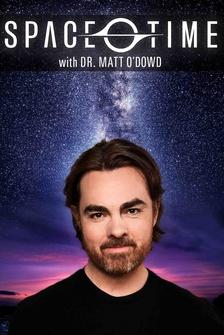Grasslands are threatened right now, especially in the California landscape.
One key factor to protecting this landscape is to introduce sheep.
Alright, who wants to shepherd?
Let's go, kids.
Come on!
Why not take a creature that's already adapted to support the system that's already existing?
We're going to go see Shane and the sheep.
Come on.
It's beautiful.
The Perennial Grazing Flock - we got some four-leggeds and we got some two-leggeds.
So it's Christian and I.
And then that's our big, fluffy guard dog.
His name's Shane.
Come on, give me a hug.
Oh, there you are.
Good boy.
Tell us what happened last night.
You kind of smell like skunk.
And then we have Jane, Nelly, Cupcup and Max.
Did I say the sheep?
Obviously the sheep.
Let's go see the flock.
Come on.
A lot of people ask us, why sheep?
And the answer is biodiversity and fire suppression.
We used to think of soil as just a structure of holding things up, and that's it.
But now, we're looking at soil in this whole other new vision of the water retention.
And how do we best build soil health?
The benefit of what sheep do is they eat, they trample and they poop.
And that all has so much power.
What they're doing is they're breaking down all that matter, and that allows more water retention in soil.
And fire is still a huge threat to the California landscape.
So, if we don't manage our grasslands properly, then fire can just rip through those in seconds, which makes it a real key ecosystem to protect.
So yeah, I think it's really a time in the California landscape to bring the sheep, or the smaller ruminants, back, to bring the sheep, or the smaller ruminants, back, to take the new age practices, as well as the ancient tradition of shepherding, and try to heal this landscape, at least when I'm on this earth.
So, here's our flock of 620 sheep.
This is an organic winery and a really good indicator to see is that there's vegetation between the vines here.
When you drive around different vineyards, you'll see that this is just barren soil.
And that's because there's herbicides laid here.
And so the sheep are great in a vineyard practice because they're eating under these vines, you know, they're a lawnmower.
You know, some operations come in with tractors and till up the soil, but that's all labor and a lot of time, which in the current economic of California, you know, labor, diesel, fuel is costing a lot more.
So this is, you know, in the springtime, sheep come, and they can eat two and a half acres in a day.
But everyone's looking pretty good.
When we grow monocultures, we're washing away the nutrients and limiting the biodiversity.
Then you'll start seeing soil degradation.
Then you'll start seeing erosion.
Then you'll start seeing disease and viruses.
So we need biodiversity, especially here specifically.
And what I know about sheep is that when managed right, they do increase biodiversity.
And I'm not just talking about plants, but the greatest thing about sheep poo is that it's nutrient dense for the soil, which helps with nitrogen cycling, carbon sequestration and things that we can all test for today in modern science, which helps balance in, you know, one would say a monocrop cultivated landscape.
The silver lining here is that if there's nothing to do, you just build more fence.
Our style of grazing is rotational grazing.
So we set up this polywire fence in two-acre blocks, and then after 24 hours, we move them and this allows the sheep to graze at an even consistency.
So all the grass, you'll see, once the sheep go through, it's all leveled.
What happens if you don't contain them in the blocks is that you’ll just see overgrazed pastures run off with water.
So they can do harm as well, if you don't make plans and be responsible for, you know, making sure that they're happy because if they're not, they'll break out of the fence.
And then you have ten other more issues.
And that's never fun.
I'd never grew up being like, I'm going to be a shepherd.
But I was going to do something different and there was going to be no script for what I was going to do.
And that probably stems from me not really following directions that well.
I grew up in the suburbs of Chicago.
Rollerblading, pond hockey, tons of sports teams.
And I knew that there was other ways of living that complemented my soul and what I wanted to experience and I knew that there was a partner out there that wanted to do that with me.
Just had to find him.
Babe, you have any stories?
- Yeah, there's a lot of lessons learned.
We always say that the fence, the fencing teaches you lessons the hard way.
Yeah, it's kind of like it's just a meditation, where it’’s like, you can't be attached to it because in less than 24 hours, you'll be rolling it up again.
But it's a good practice to come back to.
We built the pen, so we're going to walk the sheep up the double decker and that's going to take 120 sheep and we'll head off to our next vineyard.
Max, come on.
Nelly, come.
Let's go to work.
Come on, Nels.
All right.
Oh, everyone's resting.
They're all digesting right now.
I swear, ladies, we're taking you to another lush pasture.
Maxie, go get em.
Go on, go get em.
It could be an epic failure or it could go easy.
Dad, you can stand out and do the count.
- The first thing is just to load up the corrals.
And then we’re just kind of giving them a hard back so that the way forward is the best decision for them.
- This is it.
We're doing it.
Up!
This is my business office.
Please step in.
You're not gonna go.
Alright, here they come.
John, what are we at?
- 13, 14, 15.
24.
25.
I - I lost count.
- Johnny!
[laughs] Alright business girls, you're out of here.
That was a very simple one.
Part of our shepherding is that we move with the sheep.
So we don’t commute back home to where we live or back to our ranch.
We just take the whole caravan and pack it.
Wherever the sheep are, we’re there, being stewards with them.
The relationship between shepherdess and their sheep is one of calmness and loyalty.
You really have to make sure you build that trust with the sheep.
And so, every time you're rotating them with proper nutrition and keeping them fed, they gain that trust.
And then soon, you know, they're calling out to you.
Maxie, where's your stick?
Where's your stick, buddy?
You know, everyone says the hills are golden in California.
But it's really all the annual grasses have died off.
The difference between an annual grass and a perennial grass is that annual grass don't spend their energy developing a root structure, whereas a perennial grass will develop deep root systems for pockets and channels for water.
And so, the reason why perennials are so important to the landscape in California is that it's holding the moisture and the minerals in the soil.
And so, adding our living lawnmowers to the landscape, it helps bring back the perennial grasses, the perennial shrubs, and compete with these annuals that are pinching out more of the native species.
Right now, with all these annual grasses and all this golden organic matter, the fire is just heating up, and that's what's causing more wind to happen.
You know, we're not just talking like a little campfire, we’re talking hectares and hectares going up.
And that's creating a lot of heat and it's creating its own climate.
When we come in and we graze with the sheep, we will bring down the annual matter to low.
And then, it's a great opportunity for the perennials to start coming up.
Once a perennial establishes itself, you can see more minerality, more carbon cycling, nitrogen cycling.
All those help with the climate change crisis.
We're never going to get the California landscape back to all the natives.
I'm not trying to promote that.
It’s just, we have to have a balance in the landscape and right now, we're out of balance.
Perennial Grazing packs up every 2 to 3 weeks in vineyard season.
But I'd rather be packing up every 5 to 10 days or whatever the time period is than commuting in California traffic, because that's never fun.
I was thinking like, what's the formula to shepherding?
And there isn't really a rule book or a a lot of examples of how to run your business.
Come on.
You know, it's not like business school where everyone knows it or journalism school.
Like there's no school of shepherding.
But if I just keep going back to the idea that science has tools and shepherding has tools, and if we combine our tools together, we are better together.
You know, and you could say that like the whole climate change in general, we need like any skill we can.
You don't have to, like, know all the facts and figures or be the scientist or have gone to school.
Like, you just have to show up.
Babe, I'm just like, slowly packing up stuff.
How are you?
- It’s all good.
Anyways, yeah.
Do you think you guys can have the sheep in the corral all ready at 4:20?
Yeah.
Maxie’s ready.
He's resting.
And Nelly is excited to be the sweeper.
- Alright, exactly.
Okay.
Sounds good.
I'll give you another heads up when we go.
Okay, great.
We'll see you in an hour.
- Okay, sounds good.
Thanks.
Love you, bye.
- Bye.
My Valentine.
Alright.
Guess what, guys?
One more sheep load.
And that's it!
We're in the business of land management.
And we're not going to let owning land stop us from cultivating what brings us joy and what we know can live a better life on this planet.
There needs to be more change and more action.
And yeah, for us, shepherding is definitely not the easy way.
But it's something we believe in that evolved with the Earth and we are just the stewards.
I want to encourage so many other women to join in this revolution, and if not a revolution, just stand up for what you believe in.
Healing the earth is going to take a long time because there's no quick fix.
And I'm just one woman in a flock of 600 sheep right now standing up.
So, just go simple and try because there's a million ways to create















